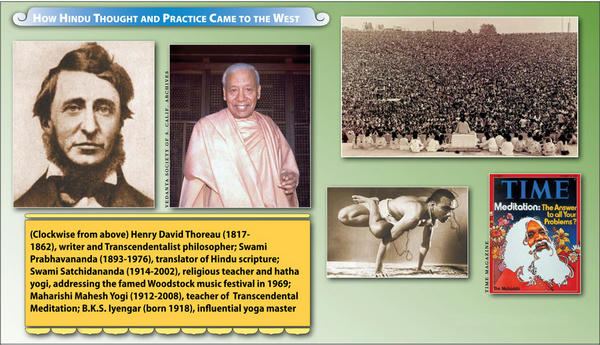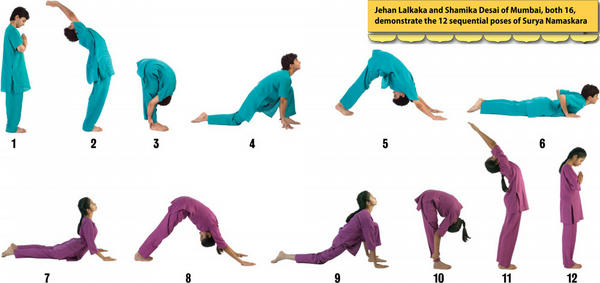The Impact of Hindu Ideas Today
1. Hindu ideas and ideals are changing the way people all over the world think and act.§
2. Hindu metaphysical concepts have been well known in the West for about 200 years.§
3. Yoga, meditation, ayurveda, even Indian food and movies are increasingly popular.§
India’s profound spiritual knowledge and yoga practices influence the world.
Key Terms§
![]() HINDUISM TODAY’S TEACHING STANDARDS§
HINDUISM TODAY’S TEACHING STANDARDS§
If this were YOU...
You have had a persistent cough for many months. A Western doctor has given you medicine to control the symptoms, but it won’t cure the underlying illness. You go to an ayurvedic doctor, who prescribes certain healing herbs and a better diet. It is more work on your part, and it will take time for his remedy to make you well.§
Do you try ayurveda or stay with your first doctor? §
BUILDING BACKGROUND: In this section we discuss India’s “soft power” as opposed to its “hard power.” Hard power is a nation’s military and/or economic strength used to impact international affairs. Soft power refers to the influence of a nation’s ideas, culture and values on the way others believe, think and act.§
Dharma and the Future
In our modern world, Hindu ideas have spread far and wide from their origin in India. In Chapter Four (covering 1850 to 1947), we spoke of two of these ideas: respect for all religions and political change by nonviolent methods. In 2009, the Pew Forum on Religion and Public Life conducted a poll in which they asked Americans about their belief in a few “Eastern” concepts. The results showed that 24% believe in reincarnation, 23% in “yoga not just as exercise but as a spiritual practice” and 26% in “spiritual energy located in physical things like mountains, trees, crystals.” This is nothing new: polls of Americans show similar numbers of believers, at least in reincarnation, as far back as the 1950s.§
When did these ideas come to America? Many Native American tribes believe in reincarnation and spiritual energy located in physical things. While traveling in the American West in the 1890s, Swami Vivekananda was astonished to meet a cowboy who said he firmly believed in reincarnation. He may have learned the idea from the Native Americans, or perhaps discovered it on his own.§
These spiritual concepts shared by many faiths throughout the world tend to be identified as Eastern or specifically Hindu, because it is within the Hindu tradition that they are logically and clearly explained and their theological foundations clarified. In this section we will explore how Hindu metaphysics (the study of reality beyond our five senses) came to the West. Hindu theology, yoga, meditation and ayurveda found a receptive audience.§
Hindu Ideas Spread to the West§
Hindu metaphysics arrived in America and Europe early in the 19th century in translations of Hindu scriptures—the Vedas, Upanishads and Bhagavad Gita. Scholars, writers and poets immediately found value in the concepts of karma, dharma, reincarnation and the divinity of the soul. They marveled at the Hindu concept of God as not only personal, but also immanent, (pervading all nature and humanity) and transcendent (beyond the physical universe).§
America’s 19th-century freethinkers deeply appreciated the Hindu openness to many religious paths and its freedom to choose one without condemning others as wrong. All these ideas are prominent in the writings of Ralph Waldo Emerson, Walt Whitman and Henry David Thoreau. They influenced generations of writers and scholars, notably Herman Melville, William James, T. S. Eliot, Aldous Huxley and Christopher Isherwood.§
Hindu teachers first came to the West in the late 19th century. Many were prominent, but Swami Vivekananda (see Chapter Four) was by far the most influential. He and other swamis and yoga teachers were popular with the educated and artistic communities, including famous scholars and actors. In the 1940s and 50s, Swami Prabhavananda translated the Bhagavad Gita and Upanishads with the help of American devotees who were skilled writers. His clear and approachable books became popular, bringing these Hindu texts to millions in the West. Paramahansa Yogananda’s classic Autobiography of a Yogi, published in 1946, introduced the idea of a life of spiritual striving and experience in story form.§
The 1960s brought a wave of Hindu teachers to the West. Their teachings were eagerly welcomed by the youth of the New Age. Since then, karma, reincarnation and other Hindu ideas have become common in the songs, movies, art and novels of the West.§

Central to Hindu ideas is the discipline of yoga. Hatha yoga, a system of physical postures, is the most widely recognized form of yoga in the West today. Generations of movie stars and dancers, back to the early 1900s, have helped publicize its benefits. In the West, hatha yoga is mostly promoted as a form of exercise in the West. But in India, it is part of a broader practice called ashtanga yoga, literally “eight-limbed yoga.” Hatha yoga is the third of the eight limbs. The first two limbs are ethical ideals and religious practices, including nonviolence, chastity, honesty, piety and worship.§
Hatha yoga poses have fun names such as downward dog, cobra, plough and lotus, which describe the shape the body takes in the position. Poses are done in series to quiet the mind and emotions and relax the body. To Hindus, hatha yoga is not just a form of exercise, but an essential preparation for meditation and development of spiritual consciousness.§
The fourth through eighth limbs of ashtanga yoga relate to meditation. The initial objective of meditation is to quiet the mind and emotions in order to move awareness to the higher chakras. This is done in part through hatha yoga, which calms the body, and in part through breath control, which calms the emotions and quiets the thinking mind. One breath control method is to breathe in nine counts, hold one count, breathe out nine counts, hold one count and repeat. After a while, you can do the counting on your heartbeat. The object of meditation is not to sit and think, but to go beyond thinking into higher consciousness.§

Ayurveda§
India has one of the world’s oldest systems of medicine, already described in Chapter One. Called ayurveda, “science of life,” it is gaining popularity in the West. It is a holistic system which deals with the causes of disease, not just the symptoms. Ayurveda emphasizes a healthy diet, especially not overeating, and regular exercise and massage. It makes use of thousands of herbs, including common spices such as pepper, cinnamon and turmeric. Indian cooking uses the knowledge of ayurveda. The spices are used for their medicinal effects as well as for taste. A key practice of ayurvedic doctors is “pulse diagnosis,” analyzing the patient’s pulse to identify any imbalances or disease in the body.§
Culture§
India’s Bollywood films, with their rhythmic dancing and singing, are popular worldwide. The word Bollywood mixes Hollywood with Bombay (now Mumbai), center of India’s huge film industry. While they are not designed to promote religion or culture, these films convey the charming flair and flavor of Hindu lifestyles to people everywhere.§
India is known for its varied and mostly vegetarian cuisine. It is commonly ranked among the top four, along with French, Chinese and Italian. The main ingredients of Indian cooking are rice, wheat flour, beans and a wide variety of vegetables and spices. Some Indian foods are notoriously hot, but most are mild. Indian restaurants abound in the West, especially in the UK, which has over 9,000!§
SURYA NAMASKARA§
Hatha means “sun-moon” and is the name of the popular yoga exercises so common around the world. The name comes from the aim of balancing the male (the “sun” part) and female (the “moon” part) currents, mentioned in our next section on chakras. Each pose has a specific effect upon the nerve system. The most famous set of poses is Surya Namaskara—the Sun Salutation, or greeting the Sun God. It tunes mind and body, while being a good workout! In India you can see people alone or in groups performing Surya Namasksara to the rising Sun.§
CHAPTER SUMMARY
Following independence, India rebuilt itself. It succeeded, improving its economy, halving the rate of poverty, doubling life expectancy and improving literacy six-fold. India is still a developing nation but is on track to be a superpower in the decades ahead.§
India’s heritage of spirituality and religious thought continues to dramatically influence the world, as it has for centuries. Scholar Stephen Cohen said, “India has become a global cultural superpower. Its soft power is second to none. Whether at the highest level of philosophy or the lower level of Bollywood, Indian culture is spreading.”§
Even in terms of hard power, India is already impressive. According to a 2010 report by the US government, India is today the third most powerful country in the world in terms of gross domestic product, defense spending, population and technology. The report says that as of 2010 the US holds 22% of global power, China 12% and India 8%. Japan, Russia and Brazil each hold less than 5%. By 2025, the report predicts, US power will decline to 18%, China’s will rise to 16% and India’s to 10%. The future of modern India appears bright as she overcomes centuries of suffering to resume her historic position as a leading nation in the world.§
REVIEWING IDEAS, TERMS AND PEOPLE§
- List: What key Hindu concepts are popular in the West?
- Explain: How did Hindu ideas come to America in the 19th and 20th centuries?
- Describe: How do hatha yoga and meditation impact the body? What is the purpose of breath control?

- Debate: A few students want to start a yoga class as part of phys-ed. Others object, arguing that it is a religious practice which should not be allowed. Which side do you take? Why?
ACADEMIC VOCABULARY§
theology§
the systematic study of the nature of God and religious belief§
yoga§
“union,” physical and mental practices intended to awaken spiritual qualities§
ayurveda§
India’s ancient medical science§
New Age§
a Western spiritual movement drawing on Eastern thought§
holistic§
based on the idea that the parts of a whole are interconnected§


